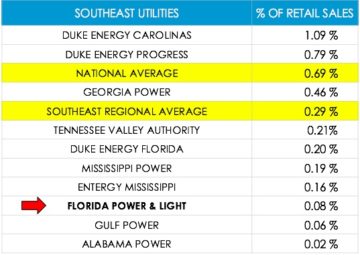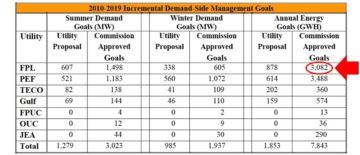FPL's resistance to utility energy efficiency isolates the company from their corporate peers and dragged Florida down to the bottom of state rankings.
Forest Bradley-Wright | February 20, 2019 | Energy Efficiency, Florida, UtilitiesThe following is the fourth in a series of in-depth posts looking at energy efficiency achievements and missed opportunities for Southeastern states and utilities, as documented in SACE’s recently published Energy Efficiency in the Southeast 2018 Annual Report. You can check out previous posts on SCE&G, North Carolina / Duke, and Georgia.
—

Florida Power & Light (FPL) provides electricity to roughly half of all residents and businesses in Florida—the nation’s 3rd most populous state. For years, however, the company has severely limited these same customers’ access to the least expensive energy resource, utility efficiency programs. The resulting wasted energy increases electricity sales, which in turn props up FPL’s plans to build more power plants and collect higher bills from its customers.
Despite their size, sophistication, and publicly projected modern image, FPL’s resistance to utility energy efficiency has dragged Florida down to the bottom end of state rankings. Even among utilities in the Southeast, FPL’s performance is embarrassing, and compared to major utilities outside the region they fare far worse.
Hurting Those Who Can Least Afford It
Low- to moderate-income households are especially hurt by restrictions on efficiency programs that reduce energy waste. Comprising approximately 36% of Florida’s population, these customers would benefit most from the financial savings of the highly effective efficiency measures that FPL doesn’t provide. For households that are struggling financially, saving on energy bills can be the difference between having enough money for vital food, medicine and other basic needs.
Not only has FPL restricted the overall availability of efficiency programs, since 2012 their programs for income-qualified residents made up less than 1% of the already paltry budget they allocate for efficiency. This is far out of alignment with both the state’s population mix, and compared to FPL’s peer utilities around the country.
Florida’s Moment of Political Leadership, Swiftly Undermined
A decade ago, Florida’s political leadership took a significant step forward for energy efficiency. With support from Governor Charlie Crist, in 2008 the state legislature enacted a number of important changes to the Florida Energy Efficiency and Conservation Act including:
- Establishing goals for demand-side renewable energy resources
- Consideration of efficiency investments in generation, transmission, and distribution efficiency improvements
- Clarification of the costs and benefits to be considered
- Authorization to provide rewards and penalties for conservation achievements
The next year, the Florida Public Service Commission followed suit and approved “aggressive” new goals for Florida’s major utilities, based on an Enhanced Total Resource Cost (E-TRC) test, and authorized approximately $24 million for solar electric and heating pilot programs. The Commission then approved substantially expanded program plans for all but two major electric utilities.

Conspicuously, FPL and Progress Energy Florida held out…before turning everything on its head the year after. With a newly elected Governor taking office in 2011, FPL saw a chance to turn changing political tides to their advantage, ultimately undoing the recent progress on efficiency with swift and devastating effect.
FPL never came into compliance with the energy saving goals the Commission had set. Instead, the program plans they submitted effectively undermined the earlier requirement and reduced the savings targets from 3,082 GWh a year down to 204 GWh – a staggering 93% drop. In each of the next three years, FPL’s efficiency performance flat-lined. Year after year, they failed to meet even the anemic new targets in their program plans – running deficits as much as 45% below the already dramatically lowered savings goals.
FPL’s backslide set a negative precedent, and efficiency savings levels at other Florida utilities soon tanked as well. Particularly egregious was Gulf Power, a Southern Company affiliate, who fell from a respectable 0.8% annual efficiency saving in 2013 to just 0.06% three years later, a 92% slide.

As reflected in SACE’s Energy Efficiency in the Southeast 2018 Annual Report, Florida is now among the worst performing states for utility energy efficiency in one of the lowest performing regions of the country. By comparison, the national average is five times higher, and leaders like California, Massachusetts, Rhode Island, and Vermont achieve between 15 and 25 times more annual energy savings for their customers than is captured in Florida.
How Efficiency is Undermined in Florida
Three key factors underpin FPL’s strategy to minimize efficiency offerings that would help its 5 million plus customers save energy and reduce their electric bills.
- FPL misrepresents the scale of opportunity, by underestimating the “achievable efficiency potential” used to determine energy saving targets.
- FPL promotes use of the RIM Test, a deeply flawed method of cost-benefit analysis that drastically reduces efficiency investments by failing to account for the higher cost of adding power generation to supply the energy that is being wasted.
- FPL strips out any efficiency measures with a financial payback of two years or less. To be counted towards energy saving targets, the payback must take more than two years to benefit the customer. Florida is the only state to use this method in setting efficiency goals.
By systematically eliminating efficiency measures in these ways, huge amounts of energy continues to be wasted unnecessarily. All this wasted energy causes customers to have to pay for more expensive sources of energy, including construction of over $4.2 billion of new gas-fired power plants. Across the country, efficiency is proven to consistently beat gas-fired power plants on price. But in Florida, it isn’t given the chance.
2019 FEECA Targets: A Chance to Right the Wrong
The Florida Energy Efficiency and Conservation Act proceedings occur only once every five years. In 2019, SACE will press the Florida Public Service Commission to reset and improve the energy conservation goals for the state’s largest utilities. It is time to turn around Florida’s embarrassing energy efficiency record. It is time to reject FPL’s efforts to smother efficiency. It is time for FPL to stop holding Florida back. Since 1980, Florida law has recognized that energy efficiency is key to affordably meeting the state’s energy needs and saving residents money. As the largest, most sophisticated state-sanctioned monopoly business in Florida, FPL knows better and should do better.
Note: This January, FP&L parent company NextEra acquired Gulf Power, increasing its monopoly reach to more than half of Florida’s electricity customers.
Read Part 1, giving an overview of the annual report.
Read Part 2 of the blog series where we look at SCE&G who are at a crossroads for energy efficiency.
Read Part 3, examining Georgia Power’s energy efficiency efforts.
Learn more about SACE’s Energy Efficiency Efforts here.